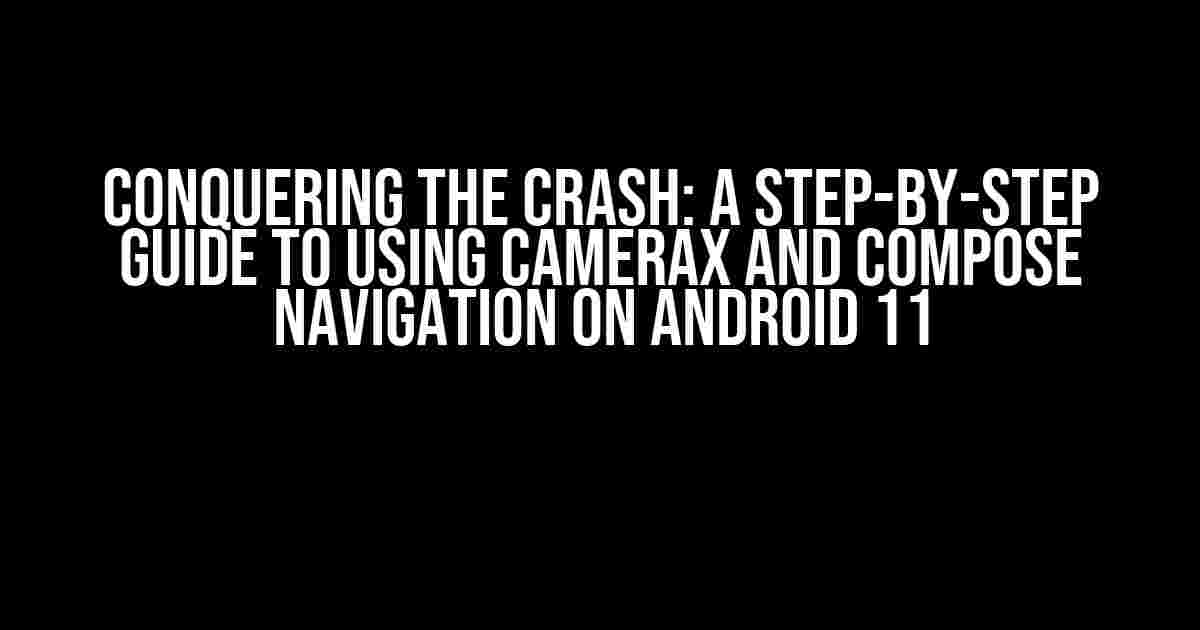If you’re an Android developer, you’ve probably encountered the infamous “Crash with CameraX and Compose Navigation on Android 11” error. It’s a frustrating issue that can bring your app development to a grinding halt. But fear not, dear developer! In this comprehensive guide, we’ll walk you through the process of resolving this crash and getting your app up and running smoothly on Android 11.
Understanding the Crash
Before we dive into the solution, let’s take a closer look at what’s causing the crash. The issue arises when you’re using CameraX, a Jetpack library for camera-related functionality, alongside Compose Navigation, a navigation component for Android apps. On Android 11, the combination of these two libraries can cause a crash due to a compatibility issue.
The Error Message
If you’ve encountered this crash, you’ve likely seen an error message similar to the following:
java.lang.IllegalArgumentException: com.example.app.CameraActivity: java.lang.UnsupportedOperationException: Failed to resolve attribute at index 13
at androidx.navigation.NavController.setGraph(NavController.java:446)
at androidx.navigation.NavController.setGraph(NavController.java:427)
at androidx.navigation.NavController.setGraph(NavController.java:417)
...
This error message is telling us that there’s an issue with resolving an attribute, specifically at index 13. But what does this mean, and how do we fix it?
The Solution
Fortunately, the solution is relatively straightforward. To resolve the crash, we need to ensure that our app’s navigation graph is properly configured. Here’s a step-by-step guide to get you started:
Step 1: Update Your Dependencies
First, make sure you’re using the latest versions of CameraX and Compose Navigation. Update your build.gradle file with the following dependencies:
dependencies {
implementation 'androidx.camera:camera-core:1.1.0-alpha10'
implementation 'androidx.camera:camera-camera2:1.1.0-alpha10'
implementation 'androidx.camera:camera-lifecycle:1.1.0-alpha10'
implementation 'androidx.navigation:navigation-compose:2.4.0-alpha02'
}
Step 2: Configure Your Navigation Graph
Next, let’s take a look at our navigation graph. Create a new navigation graph resource file (e.g., nav_graph.xml) and define your app’s navigation structure:
<?xml version="1.0" encoding="utf-8"?>
<navigation xmlns:android="http://schemas.android.com/apk/res/android"
xmlns:app="http://schemas.android.com/apk/res-auto"
android:id="@+id/nav_graph">
<fragment
android:id="@+id/camera_fragment"
android:name="com.example.app.CameraFragment"
android:label="Camera" />
<fragment
android:id="@+id/home_fragment"
android:name="com.example.app.HomeFragment"
android:label="Home" />
</navigation>
Step 3: Create a NavController
In your app’s MainActivity, create a NavController instance and set the navigation graph:
@Composable
fun MainActivity() {
val navController = rememberNavController()
NavHost(navController, startDestination = R.id.home_fragment) {
composable(R.id.camera_fragment) {
CameraFragment(navController)
}
composable(R.id.home_fragment) {
HomeFragment()
}
}
}
Step 4: Use CameraX in Your Fragment
Now, let’s move on to our CameraFragment. Here’s where we’ll use CameraX to capture images:
@Composable
fun CameraFragment(navController: NavController) {
val context = LocalContext.current
val cameraProvider = remember { CameraProvider(context) }
val camera = rememberCameraState {
cameraProvider.bindToLifecycle(
context as LifecycleOwner,
CameraSelector.DEFAULT_FRONT_CAMERA,
cameraState
)
}
Box(modifier = Modifier.fillMaxSize()) {
CameraPreview modifier = Modifier.fillMaxSize(), camera = camera)
Button(onClick = { /* Take a picture */ }) {
Text("Take a Picture")
}
}
}
Troubleshooting Tips
If you’re still experiencing issues, here are some troubleshooting tips to help you resolve the crash:
- Make sure you’re using the latest versions of CameraX and Compose Navigation.
- Verify that your navigation graph is properly configured and that all fragments are correctly registered.
- Check that you’re using the correct lifecycle owner in your CameraFragment.
- If you’re using a ViewModel, ensure that it’s properly scoped to the fragment or activity.
Conclusion
And that’s it! By following these steps and configuring your navigation graph correctly, you should be able to resolve the “Crash with CameraX and Compose Navigation on Android 11” error. Remember to always keep your dependencies up to date and follow best practices for navigation and camera functionality in your Android app.
| Dependency | Version |
|---|---|
| CameraX | 1.1.0-alpha10 |
| Compose Navigation | 2.4.0-alpha02 |
By following this guide, you should be able to get your app up and running smoothly on Android 11, with CameraX and Compose Navigation working in harmony. Happy coding!
Here is the HTML code for 5 questions and answers about “Crash with CameraX and Compose Navigation on Android 11” with a creative voice and tone:
Frequently Asked Question
Get the scoop on CameraX and Compose Navigation on Android 11 – we’ve got the answers to your burning questions!
Q: What is the main cause of the crash when using CameraX and Compose Navigation on Android 11?
A: The main cause of the crash is due to the incorrect usage of the CameraX API, which can lead to a memory leak and eventually cause the app to crash. This is especially true when using Compose Navigation, as it can further complicate the camera setup process.
Q: How do I fix the crash issue when using CameraX and Compose Navigation on Android 11?
A: To fix the crash issue, make sure to properly release the camera instance when navigating away from the camera screen, and also ensure that the camera is not being used by multiple fragments or activities at the same time.
Q: What is the role of CameraX in Compose Navigation on Android 11?
A: CameraX is a Jetpack library that provides a simple and consistent API for camera functionality on Android devices. In Compose Navigation, CameraX is used to handle camera-related tasks, such as taking pictures and videos, and is an essential component of many camera-based apps.
Q: Can I use CameraX without Compose Navigation on Android 11?
A: Yes, you can use CameraX without Compose Navigation on Android 11. CameraX can be used as a standalone library to handle camera functionality in your app, regardless of the navigation architecture you choose to use.
Q: Are there any specific Android 11 features that conflict with CameraX and Compose Navigation?
A: Yes, Android 11 introduces several new features, such as scoped storage and gesture navigation, which can potentially conflict with CameraX and Compose Navigation. Make sure to test your app thoroughly to ensure that it works as expected on Android 11 devices.

